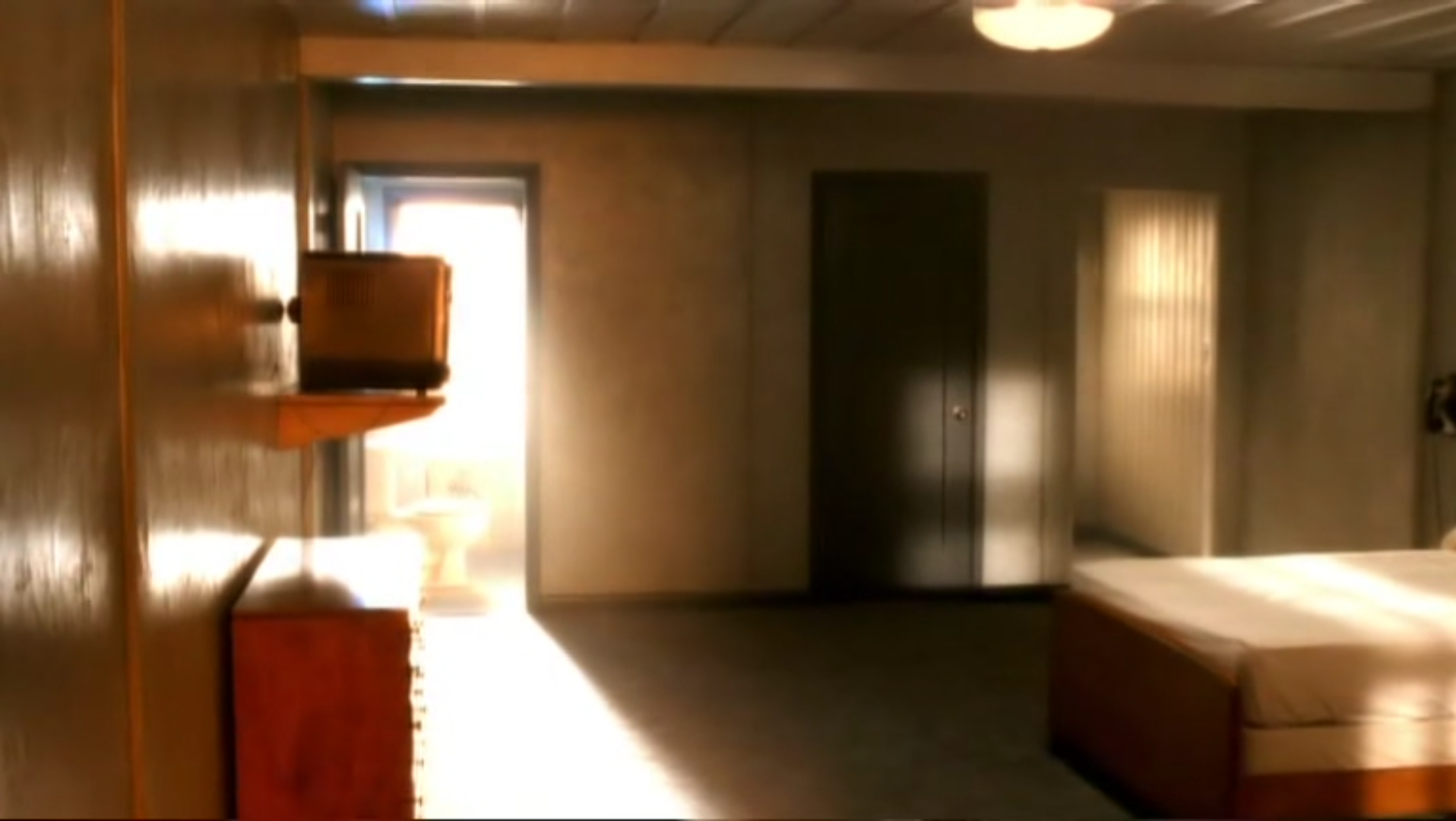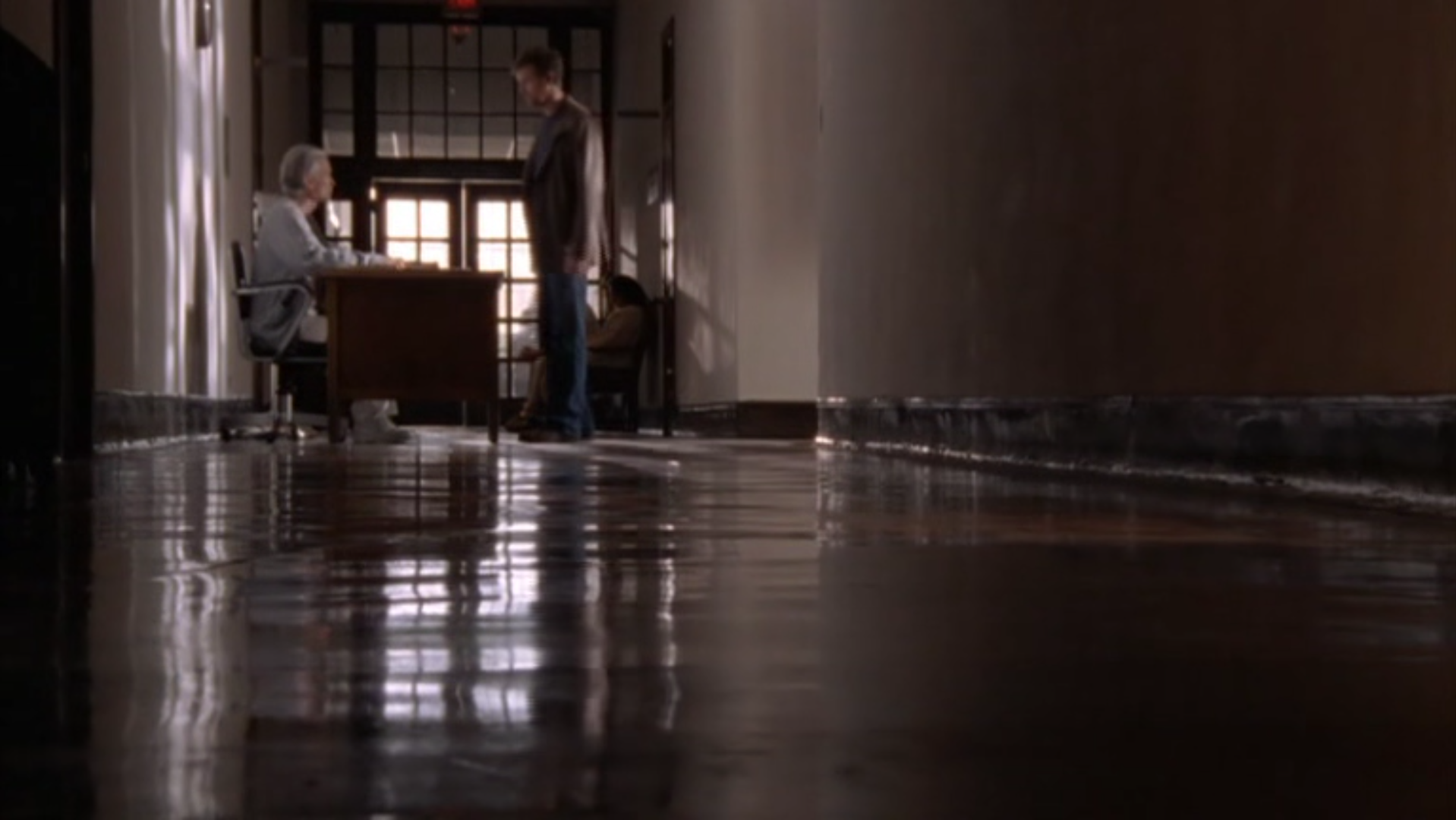The Lost Room is a television miniseries that ran on the Sci-Fi Channel in late 2006 to low ratings and mixed reviews. Intended as a launchpad for a longer series that was never made, it instead became a minor cult classic and (perhaps) the inspiration for a whole subgenre of internet horror fiction. Recently, I watched it for the second time.
The protagonist is a policeman, Joe Miller, who comes into possession of a motel room key with special properties. Turn the key in any compatible lock on any door, and that door will open into an empty motel room. If you enter the room and close the door, it won’t open into the same place you left behind. If you visualise another door anywhere in the world while holding the key, the door will open there. Not a bad way to get around.

The room in question
Early on in the series, it’s revealed that the key is one of many seemingly mundane objects with supernatural abilities, ranging from powerful to totally useless. There’s a bus ticket that teleports people to a bus stop in New Mexico, a pen that microwaves anything it touches, and a wristwatch that… hard boils eggs. There are about one hundred of these objects, and they all came from the motel room. They cannot be destroyed. When combined, they produce even stranger effects.
As Joe discovers more about the objects and the titular room, he comes into contact (and often conflict) with a myriad of different groups and individual collectors, all pursuing their own agendas: some are mere collectors, while others believe the objects to have divine significance. Before long, Joe crosses the wrong group and his own quest to learn about the objects turns from an idle curiosity to a matter of extreme personal importance.

Joe’s primary facial expression throughout the series
Though it’s only three 90-minute episodes long, The Lost Room packs more backstory and plot developments into that runtime than lesser shows manage in entire seasons. The effects and interactions of the objects and rules that govern them are well thought-out and consistent, making most of the twists gratifying rather than arbitrary. The premise remains fresh even nearly twenty years later – this is a story about supernatural events that doesn’t lean on religion, witchcraft, aliens, folklore, or any other common tropes, choosing instead to make its own distinctly modern mythology. The worst criticism I can make is that the romantic subplot comes off as wooden and entirely perfunctory.
The miniseries ends with a few loose ends and an obvious sequel hook, belying the creators’ intention to expand it, but still tells an essentially complete story and won’t leave you feeling ripped off.1
It’s often said that the Velvet Underground’s first album only sold a few thousand copies, but everyone who bought a copy started a band. The Lost Room appears to have had a similar effect on the world of internet horror fiction. Either that, or there was a case of creative synchronicity going around at the time. The series aired in December 2006, and in early 2007, both SCP-173 and The Holder of the End appeared on 4chan. Both of these pieces spawned long-running collaborative internet horror fiction projects built around numbered lists of objects with strange properties – namely, SCP and The Holders. The latter, with its exhortation that the objects “must never come together” and a collector named Legion is especially synchronistic.

In any city, in any country, go to any mental institution or halfway house you can get yourself to.
You can get the gist of both projects by reading their first entries. SCP-173 is written like an internal memo or database record describing a numbered object. It starts with Special Containment Procedures, a description of how the object is to be contained – this builds up some tension and curiosity about what the object is and does, and why these measures are necessary. The containment procedures are followed by a terse description of the object, which is horrifying and bizarre, but detailed in clinical and meticulously precise language.
A format like this lends itself to imitation, and thus SCP was born. Each of the hundreds of entries describes a bizarre object or creature that has been captured and secured by the SCP Foundation, in the style of the original SCP-173. Longer entries add logs of experiments and interviews, and liberally employ redaction to enhance the “top secret” feeling of the documents.
The Holders series is written in a looser style, evoking urban legends. The first Holders entry, The Holder of the End, is shlocky and slightly overwritten, but kinda evocative all the same. Written in second person, it provides a list of instructions for retrieving an object from a mysterious individual who can be found in “any mental institution or halfway house you can get yourself into”,2 mostly consisting of things to say and things to avoid doing. The prize for following these instructions correctly is one of 538 objects which every entry reminds us “must never come together”.
With a line like “That object is 1 of 538”, The Holder of the End was begging for imitators. Most of the additional ~537 follow the same format, beginning with “In any city, in any country” and ending with “They must never come together.” As the entries go on, the rituals become more and more elaborate, as do the gruesome consequences for failure at any stage. But at a certain point, this becomes more comical than frightening.
Knock on the second door from the left twelve times in a perfect dodecahedron pattern and then cough at precisely 86dB. If you’re even one decibel off, a demon will appear and drag you to hell by your nostrils, where you will be tortured for all eternity. Every day your ears will be pulled off and your tongue cut out, only to grow back in a more hideous and mangled form the next day.
I made up the above quote to avoid picking on any particular entry, but a lot of the stories are like this. The longer Holders stories will have many of these kinds of paragraphs, showing plenty of enthusiasm but none of the restraint required for good horror writing. The lower quality SCPs often fail in similar ways, eschewing the terseness and fragmented feeling that is essential for the series’s atmosphere in service of the writer’s enthusiasm for sharing their cool monster.
What makes the original pieces in both series work for me is all that is left unsaid. The best microfiction implies infinitely more than it explicitly describes. SCP-173 hints at the existence of other strange objects, and of a vast bureaucracy that keeps them hidden from the world. The Holder of the End hints at mystical hidden places in everyday locations, and at people irrationally driven to brave terrible danger in service of collecting objects that should not be collected.
To go back to The Lost Room, much of the allure and mystery of the objects lies in their randomness and inexplicability. Both qualities inevitably diminish as the work continues. So perhaps it’s for the best that it ends where it does.
-
The same can unfortunately not be said of the creator’s more recent television pilot, Parallels, which is deceptively packaged as a movie on some streaming services. I enjoyed it, but I guess the network wasn’t looking for an updated Sliders. ↩︎
-
These sorts of lists are a common creepypasta form outside of The Holders, being mostly elaborate variations on classic folklore rituals such as “go into a candle-lit bathroom at midnight and say Bloody Mary three times in the mirror”. ↩︎
 David Yates.
David Yates.
 ♥
♥